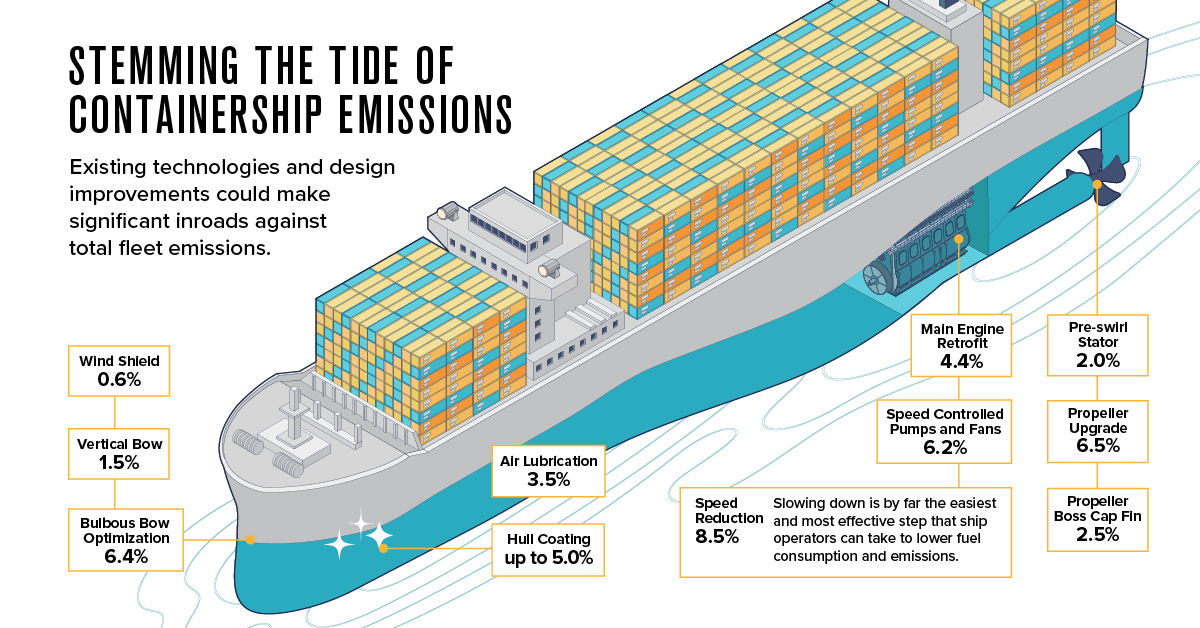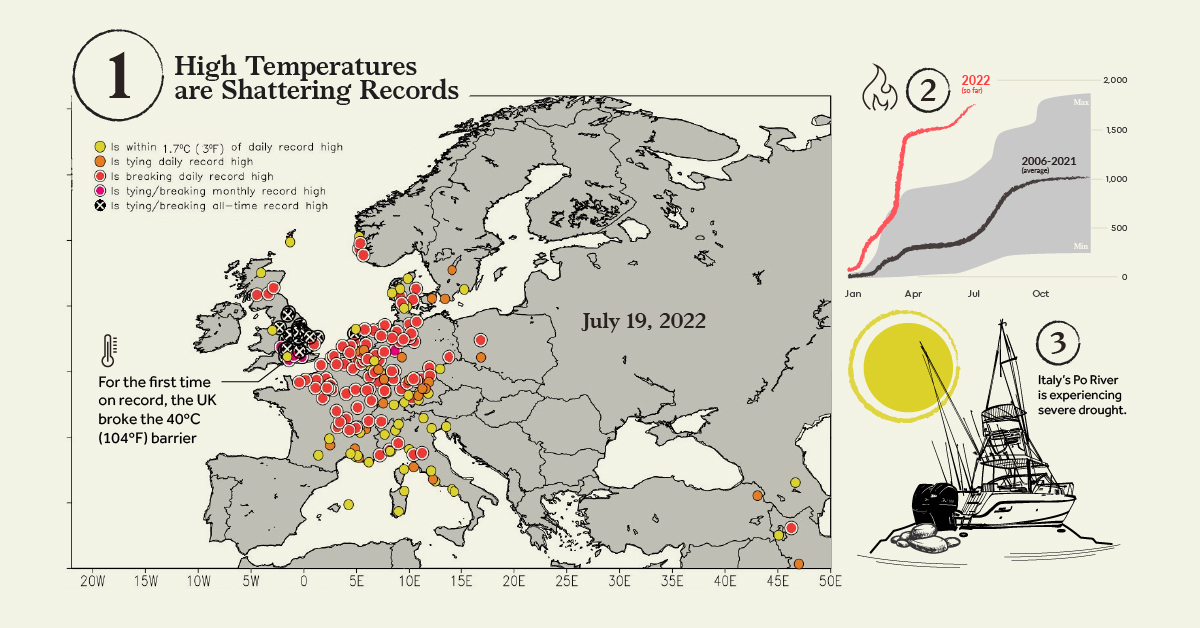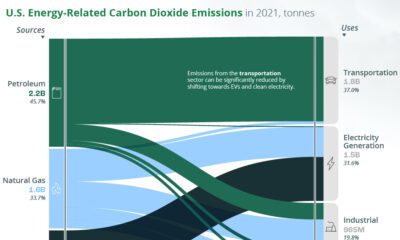Environment
5 Things to Know About Europe’s Scorching Heatwave

5 Things to Know About Europe’s Scorching Heatwave
For the last few months, Europe’s smoldering heatwave has been wreaking havoc across the region, causing destructive wildfires, severe droughts, and thousands of deaths.
The EU’s record-breaking temperatures are making headlines around the world, as experts worry these extreme heatwaves could be the region’s new normal.
Given the volume of coverage on the topic, we sifted through dozens of articles and Twitter threads (so you don’t have to) and complied a list of the five major things to know about Europe’s smothering heatwave.
① High Temperatures are Shattering Records
Temperatures have been hitting all-time highs across the region.
On Monday, July 18, dozens of towns across France reported record-breaking temperatures of up to 42°C (107.6°F). In the same week, the UK experienced its hottest day on record at 40.3°C (104.5°F), breaking Britain’s previous record of (38.7°C) 101.7°F that was set back in 2019.
The heat in London was so unprecedented, the city’s national rail service issued a warning to the public, urging passengers to stay home and only travel if necessary. Some major rail lines were even closed for parts of the day on Tuesday, July 19.
② Europe is Feeling the Burn
The smoldering heat is fueling disastrous wildfires across the continent. As of July 20, an estimated 1,977 wildfires have blazed across the region in 2022—almost 3x the average amount, according to historical data from the European Forest Fire Information System.
Mediterranean countries have been hit particularly hard, with thousands of people in Portugal, Spain, and France evacuating their homes.
③ Going With the (Low) Flow
Along with the devastating wildfires, Europe’s heatwave is also causing a series of droughts across the region.
While most European cities have at least one river or lake crossing their urban landscape, these rivers and bodies of water are at risk of drying out. For instance in early July, Italy’s Po River was experiencing a drought so severe, that the country’s government issued a state of emergency in five different regions.
④ Energy Demands are Creating an Awkward Situation
Last year, Europe set ambitious goals to cut 55% of its greenhouse gas emissions by 2030.
But, in the wake of a global energy crisis, many European countries have put their green transition plans on hold as they turn to “dirtier” fuels like coal to keep their economies running business-as-usual. This timing is a tad awkward, considering the fact the region is currently ablaze with record-breaking temperatures that experts believe are human-induced.
The aforementioned “low flow” on many European rivers are also impacting hydroelectricity and even nuclear electricity generation, as too little water is available for cooling purposes.
On the bright side, at least Germany has made some progress in the realm of renewable energy—on July 17, the country generated a record-breaking amount of electricity from solar panels.
⑤ Climate Change is a Factor, but Heatwaves are Complicated
Experts claim that climate change is playing a part in these record-breaking heatwaves. Around the world, global surface temperatures have risen by about 1.0°C (1.8°F) since the 1850s, and scientists claim this temperature increase has been indisputably influenced by human activity.
However, there may be other factors that are influencing these extreme heatwaves. While the exact specifics are difficult to nail down due to the variable nature of the climate, a recent study published in Nature Communications found that Europe’s escalating heatwaves could be partly attributed to changing air currents, which are blowing hot air from North Africa to Europe.
The Bottom Line
At least 1,500 lives have been lost so far amidst this record-breaking heatwave. And since temperatures are expected to remain high across the region for at least another week, this figure will likely increase.
European homes are generally not well equipped for exceptionally high temperatures, and since the continent has the oldest median age of any region, its population is particularly susceptible to the negative effects of extreme weather.
Livelihoods are also being impacted by the extreme weather. Temperatures are drying out soil, which is creating poor growing conditions for corn farmers in France, Romania, and Spain, the region’s top corn producers.
Long story short—Europe’s heatwave is having disastrous effects on its economy and infrastructure, as well as the overall wellbeing of the region’s population.
Update: The map from cool.wx was revised to better reflect Europe’s present day borders.
shipping
3 Ways the Shipping Industry is Addressing Climate Change
The shipping industry is responsible for 2.89% of all carbon emissions. Here are three ways it could evolve to address climate change.

3 Ways the Shipping Industry is Addressing Climate Change
The global shipping industry is on the verge of a transformation not seen since the transition from sail to steam.
In 2018, the industry emitted 1.1 billion metric tons of greenhouse gas emissions, representing 2.89% of all anthropogenic, or human-caused, emissions. And according to the International Maritime Organization (IMO) that could increase 90-130% in 2050, from a 2008 baseline.
This is the second and final part of The Shipping Industry: Plotting a Course for the Future, a two-part series from our sponsor Seaspan Corporation, that looks at three ways that containerships in particular, could evolve to become more sustainable.
1. Stemming the Tide of Containership Emissions
Unlike personal transport, which has a proven and commercially scalable technology in electric vehicles, there’s no silver bullet for shipping. However, existing technologies and design improvements could help make significant inroads against total fleet emissions.
According to data from Seaspan, propeller upgrades (6.5%), hull coatings (up to 5.0%), and main engine retrofits (4.4%) won’t bring emissions to zero on their own, but taken together they add up to big savings.
| Technology | Annual Abatement potential |
|---|---|
| Speed reduction | 8.5% |
| Propeller Upgrade | 6.5% |
| Bulbous bow optimization | 6.4% |
| Speed Controlled Pumps and Fans | 6.2% |
| Hull coating | 5.0% (up to) |
| Main engine retrofit | 4.4% |
| Air lubrication | 3.5% |
| Propeller boss cap fin | 2.5% |
| Waste Heat Reduction | 2.2% |
| Pre-swirl stator | 2.0% |
| Weather Routing | 1.7% |
| Autopilot Upgrade | 1.7% |
| Vertical bow | 1.5% |
| Wind shield | 0.6% |
| High-Efficiency Lighting | 0.4% |
Interestingly, the biggest potential impact could come from slowing down ships (8.5%), which lowers fuel consumption and as a consequence, emissions. In the race to net zero, slow and steady could very well win the race.
2. Sailing the Ocean Green
In the long run, though, design tweaks don’t address the elephant seal in the room, which is the industry’s reliance on fossil fuels. Ships that run on alternate fuels, like ammonia, methanol, and even wind-power, are all in development, but many of the technologies are still in the early stages.
To help spur development, a group of countries at COP26, the annual UN climate conference, committed to establishing green shipping corridors where vessels would run on alternate fuels. A total of 24 countries signed the Clydebank Declaration, including the U.S. and the UK, and together they hope to catalyze the shift to zero emission shipping.
3. Leaving Fossil Fuels High and Dry
Many ship owners and operators are looking at Liquid Natural Gas (LNG) as a transitional fuel, while alternate fuel technologies mature. LNG emits between 13.2% and 16.6% less CO2 than conventional bunker fuel oil, a highly viscous residual fuel that is high in sulfur, so it’s no surprise that LNG-powered containerships represent 29.23% of the existing orderbook.
But with all but 2.4% of the current global fleet running on fossil fuels, there is still a long journey ahead.
On the Right Tack
The 1997 Kyoto Protocol established the IMO as the forum for climate change action for the shipping industry, which many have criticized for not moving fast and far enough on climate change.
At the July 2023 meeting of the Marine Environment Protection Committee, the IMO adopted a new greenhouse gas strategy, which set “indicative checkpoints” for emission reductions for 2030 and 2040 in place of binding targets, and committed to hit net zero “by or around, i.e. close to 2050, taking into account different national circumstances.” The IMO also declined to put a price on carbon.
Even without firm targets, many industry players aren’t waiting to move on the climate emergency. Seaspan, the world’s largest independent charter owner and manager of containerships, is moving to green their fleet. They recently signed an agreement to retrofit 15 ships with dual-fuel engines that can also run on green methanol, with an option for 45 more.

Find out what else Seaspan is doing to get ready for the future of shipping.

-

 Markets6 months ago
Markets6 months agoCharted: The Dipping Cost of Shipping
After a dramatic spike during the pandemic, shipping costs have now fallen back to Earth. What does that mean for shippers and the economy?
-

 Energy3 weeks ago
Energy3 weeks agoHow Big is the Market for Crude Oil?
-

 Crime6 days ago
Crime6 days agoMapped: The Safest Cities in the U.S.
-

 Markets4 weeks ago
Markets4 weeks agoThe World’s Biggest Mutual Fund and ETF Providers
-

 Markets2 weeks ago
Markets2 weeks agoRanked: The Most Profitable U.S. Companies, by Sector
-

 Technology5 days ago
Technology5 days agoHow Long it Took for Popular Apps to Reach 100 Million Users
-

 Datastream4 weeks ago
Datastream4 weeks agoCan You Calculate Your Daily Carbon Footprint?
-

 Brands2 weeks ago
Brands2 weeks agoBrand Reputations: Ranking the Best and Worst in 2023
-

 Environment5 days ago
Environment5 days agoHotter Than Ever: 2023 Sets New Global Temperature Records
















